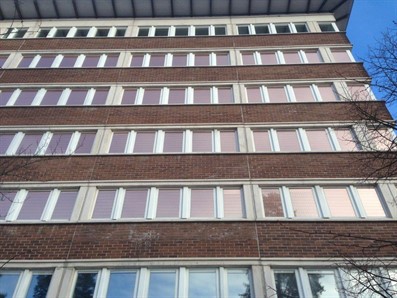The leading Swedish real estate company, Klövern, is first to apply new façade solution as integral part of its asset management strategy.
One of the key influencers on the quality and subsequently the returns of a commercial building is how tenants and users experience their everyday life inside it, i.e. comfort, indoor climate, daylight levels, views, energy consumption, etc. By letting sustainability and the long-term user experience be the point-of-departure for its strategy, Klövern has unlocked significant potential not only vis-a-vis environmental impact and retention of tenants but also in the overall financial reality and predictability of ownership.
The solution
When Karl Frisell, head of business unit Stockholm North, came across a new innovative solar shading solution called MicroShade he found that the technology and its benefits resonated very well with Klövern’s approach to strategic asset management.
MicroShade is a new type of passive solar shading which uses built-in micro-lamellas to reflect 90% of the sun’s unwanted energy while preserving the access for natural daylight into the building and providing a clear view outside without the colour-loss otherwise associated with built-in solar shading in glass.
“To begin with, we were excited about the obvious advantages of the MicroShade solution in terms of its impact on the indoor climate and comfort”, says Karl Frisell, ”but it soon became clear that it could have also have an extensive impact when looking at it in an ownership perspective and this led to development of the strategic approach to asset management we call the Technological Value Chain.”
Technological Value Chain
In most real estate development scenarios, changes in different technologies provide only incremental improvements on separate aspects of a building. However, when Karl Frisell bridged the gap between the immediate functional benefits provided by the MicroShade solution and the long-term financial impact it could have on the Klövern portfolio, it became clear that this was not just a matter of trying out new innovative technology it could also hold significant financial benefits.
“Looking at the cost of MicroShade glass in isolation, it could deter some owners from implementing this solution, but when you look the total cost of ownership and its returns – the result is quite surprising”, says Karl Frisell, and elaborates: “Not only do we save cost on cooling and avoid continuous maintenance and configuration of dynamic shading solutions, we also improve the quality of m2 available for letting and our tenants enjoy an improved indoor climate and overall comfort. Also, we as owners get the benefit of having a 100% predictable office solution which can carry a higher rate of letting”, and he adds: “And all this is achieved while reducing the environmental foot-print of a building with MicroShade”.
A sustainable strategy
It would seem the MicroShade solution is a perfect match for Klövern as the company already has a proven record of its commitment to reducing energy consumption across its portfolio. The strategy aiming at implementing sustainable solutions was also recognized in 2014 when Klövern received the Swedish E-prize in the Property and Public Sector category.
The tangible result of Klövern’s strategy is also seen at Tele2’s new head office where the atrium roof is being fitted with 700 m2 of MicroShade glazing. The alternative was a classic solution with a moveable screen on the inside and setting up mechanical ventilation to remove the heat. This would have given a poor view of the sky and the screen would have to be activated around 80% of the time in the summer months.
“We have chosen a glass roof to let the natural daylight into the building while keeping the unobstructed view outside. Our investment in the MicroShade solution is based on the strong belief in the value of creating a good indoor climate and reducing energy consumption,” says Karl Frisell, and continues: ”This value we convey to our tenants by not only focusing on the measurable effects in terms of lower temperature, natural daylight and reduced draft but also on the combined experience of increased comfort for people working in the building as well as the environmental improvements which have been achieved. To us, this completes the Technological Value Chain”, says Karl Frisell.

When renovating the Time Building, Klövern decided to use MicroShade instead of installing a larger ventilation system, which would have increased energy consumption without improving the comfort for users.
Proof by numbers
In order to not only base its product offering on user experiences but also make the benefits of its solution measurable and transparent, MicroShade engaged Sweco, Europe’s leading engineering and architecture consultancy company. The cooperation has resulted in a mathematical simulation model which predicts the impact of deploying MicroShade visualized through real-life parameters – from detailed indoor climate improvements to financial impact. This model is now actively used with most of MicroShade’s customers.
Next steps
The concept of the Technological Value Chain is now being ingrained in the way Klövern does business and has revealed that it is possible to combine and optimize long-term gain both in terms of user comfort, environment and financial returns. As such, approx. 43,000 m2 of the total office area at current Klövern-projects is already installed with MicroShade glazing.
“When I see technology which helps to make rental property more attractive for tenants relative to its predictable financial and environmental benefits, I make sure to use it. This is why we are now analysing our portfolio with the aim to identify where we could benefit from exchanging existing glass and solar shading solutions with MicroShade”, concludes Karl Frisell.